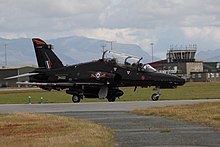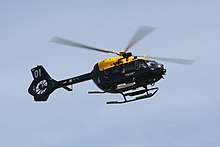RAF Valley
The airfield was constructed to the south of the village of Valley (Y Fali) or Y Dyffryn in the latter part of 1940 and opened for operations on 1 February 1941 as a Fighter Sector Station under No.
9 Group RAF with the task of providing defence cover for England's industrial north-west and shipping in the Irish Sea.
456 Squadron Royal Australian Air Force (RAAF) formed at Valley on 30 June 1941 and became operational on 5 September flying Boulton Paul Defiants.
By November the squadron had been completely re-equipped with Beaufighter IIs, and these provided defensive night patrols over the Irish Sea until March 1943, when the unit moved to RAF Middle Wallop.
[6] As a result of many accidents in the Irish Sea, due to the number of training aircraft active in the area, 275 Squadron formed at Valley in October 1941, equipped with Westland Lysanders and Supermarine Walrus amphibians and these performed Air-sea rescue (ASR) missions until the unit moved to RAF Warmwell in April 1944.
[7] The runways and taxiways were extended in early 1943, and on 19 June 1943 the United States Army Air Forces (USAAF) Ferry Terminal became operational.
In the middle of 1944 there was a daily transatlantic Douglas C-54 Skymaster service from Stephenville bringing airmen of all ranks, who continued their journeys to London on the LMSR Irish Mail train from Holyhead.
1528 BAT Flight re-formed here operating Airspeed Oxford twin-engined aircraft which were used in the Beam Approach training role until moving out on 17 December 1945.
[9] RAF Valley's USAAF ferry role was reversed as soon as the European War ended, and over 2,600 bombers passed through on their way back to the US for redeployment, each carrying 20 passengers and crew.
The then Duke of Cambridge, Prince William, now heir apparent to the British Throne, was assigned to C Flight, 22 Squadron at RAF Valley, as a pilot flying the Sea King search and rescue helicopter.
[16] On 20 March 2018 a BAE Systems Hawk of the Red Arrows aerobatic team crashed, killing Corporal Jonathan Bayliss, an engineer.
The squadron operates a fleet of 10 Texan T.1s, so that RAF Valley is now home to two-thirds of fast jet training, delivering both basic and advanced courses.
[20] In May 2020, Virginia Crosbie, MP for Ynys Môn and members of the Senedd wrote to the Ministry of Defence (MoD) seeking assurance that travel to and from the base was limited to critical journeys during the COVID-19 pandemic.
[22] He had flown from Fairoaks Airport and had noticed RAF Valley on Google Earth and decided to land there as Wikipedia said it served civilian traffic.
[22] The Ministry of Defence said that while civilian traffic were allowed at its sites, 24 hours notice is required to make sure it does not impact military activity.
On 8 June 2022, the Welsh Government axed the service, leaving the purpose-built civilian airport terminal disused.




